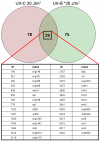Transcriptional responses to biologically relevant doses of UV-B radiation in the model archaeon, Halobacterium sp. NRC-1
- PMID: 18759987
- PMCID: PMC2556686
- DOI: 10.1186/1746-1448-4-13
Transcriptional responses to biologically relevant doses of UV-B radiation in the model archaeon, Halobacterium sp. NRC-1
Abstract
Background: Most studies of the transcriptional response to UV radiation in living cells have used UV doses that are much higher than those encountered in the natural environment, and most focus on short-wave UV (UV-C) at 254 nm, a wavelength that never reaches the Earth's surface. We have studied the transcriptional response of the sunlight-tolerant model archaeon, Halobacterium sp. NRC-1, to low doses of mid-wave UV (UV-B) to assess its response to UV radiation that is likely to be more biologically relevant.
Results: Halobacterium NRC-1 cells were irradiated with UV-B at doses equivalent to 30 J/m2 and 5 J/m2 of UV-C. Transcriptional profiling showed that only 11 genes were up-regulated 1.5-fold or more by both UV-B doses. The most strongly up-regulated gene was radA1 (vng2473), the archaeal homologue of RAD51/recA recombinase. The others included arj1 (vng779) (recJ-like exonuclease), top6A (vng884) and top6B (vng885) (coding for Topoisomerase VI subunits), and nrdJ (vng1644) (which encodes a subunit of ribonucleotide reductase). We have found that four of the consistently UV-B up-regulated genes, radA1 (vng2473), vng17, top6B (vng885) and vng280, share a common 11-base pair motif in their promoter region, TTTCACTTTCA. Similar sequences were found in radA promoters in other halophilic archaea, as well as in the radA promoter of Methanospirillum hungatei. We analysed the transcriptional response of a repair-deficient DeltauvrA (vng2636) DeltauvrC (vng2381) double-deletion mutant and found common themes between it and the response in repair proficient cells.
Conclusion: Our results show a core set of genes is consistently up-regulated after exposure to UV-B light at low, biologically relevant doses. Eleven genes were up-regulated, in wild-type cells, after two UV-B doses (comparable to UV-C doses of 30 J/m2 and 5 J/m2), and only four genes were up-regulated by all doses of UV-B and UV-C that we have used in this work and previously. These results suggest that high doses of UV-C radiation do not necessarily provide a good model for the natural response to environmental UV. We have found an 11-base pair motif upstream of the TATA box in four of the UV-B up-regulated genes and suggest that this motif is the binding site for a transcriptional regulator involved in their response to UV damage in this model archaeon.
Figures




Similar articles
-
UV irradiation induces homologous recombination genes in the model archaeon, Halobacterium sp. NRC-1.Saline Syst. 2005 Jul 4;1:3. doi: 10.1186/1746-1448-1-3. Saline Syst. 2005. PMID: 16176594 Free PMC article.
-
The uvrA, uvrB and uvrC genes are required for repair of ultraviolet light induced DNA photoproducts in Halobacterium sp. NRC-1.Saline Syst. 2006 Sep 13;2:11. doi: 10.1186/1746-1448-2-11. Saline Syst. 2006. PMID: 16970815 Free PMC article.
-
Genetic and transcriptomic analysis of transcription factor genes in the model halophilic Archaeon: coordinate action of TbpD and TfbA.BMC Genet. 2007 Sep 24;8:61. doi: 10.1186/1471-2156-8-61. BMC Genet. 2007. PMID: 17892563 Free PMC article.
-
Repair of UV damage in Halobacterium salinarum.Biochem Soc Trans. 2003 Jun;31(Pt 3):694-8. doi: 10.1042/bst0310694. Biochem Soc Trans. 2003. PMID: 12773185 Review.
-
Changes in biologically active ultraviolet radiation reaching the Earth's surface.J Photochem Photobiol B. 1998 Oct;46(1-3):5-19. doi: 10.1016/s1011-1344(98)00182-1. J Photochem Photobiol B. 1998. PMID: 9894350 Review.
Cited by
-
Impact of a homing intein on recombination frequency and organismal fitness.Proc Natl Acad Sci U S A. 2016 Aug 9;113(32):E4654-61. doi: 10.1073/pnas.1606416113. Epub 2016 Jul 26. Proc Natl Acad Sci U S A. 2016. PMID: 27462108 Free PMC article.
-
Bioengineering radioresistance by overproduction of RPA, a mammalian-type single-stranded DNA-binding protein, in a halophilic archaeon.Appl Microbiol Biotechnol. 2014 Feb;98(4):1737-47. doi: 10.1007/s00253-013-5368-x. Epub 2013 Nov 29. Appl Microbiol Biotechnol. 2014. PMID: 24292079 Free PMC article.
-
Insights into the Lysine Acetylome of the Haloarchaeon Haloferax volcanii during Oxidative Stress by Quantitative SILAC-Based Proteomics.Antioxidants (Basel). 2023 Jun 1;12(6):1203. doi: 10.3390/antiox12061203. Antioxidants (Basel). 2023. PMID: 37371933 Free PMC article.
-
Genomic Analysis of Haloarchaea from Diverse Environments, including Permian Halite, Reveals Diversity of Ultraviolet Radiation Survival and DNA Photolyase Gene Variants.Microorganisms. 2023 Feb 28;11(3):607. doi: 10.3390/microorganisms11030607. Microorganisms. 2023. PMID: 36985181 Free PMC article.
-
'All About' Extremophiles.Fac Rev. 2023 Nov 7;12:27. doi: 10.12703/r/12-27. eCollection 2023. Fac Rev. 2023. PMID: 38027090 Free PMC article. Review.
References
-
- Perdiz D, Grof P, Mezzina M, Nikaido O, Moustacchi E, Sage E. Distribution and repair of bipyrimidine photoproducts in solar UV-irradiated mammalian cells. Possible role of Dewar photoproducts in solar mutagenesis. J Biol Chem. 2000;275:26732–26742. - PubMed
LinkOut - more resources
Full Text Sources
Research Materials

